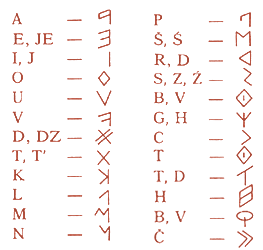The
enigma of the Venetic script 1.
Recent discoveries and new hypothesis
The Venetic people entered
Europe in 13th century BC, and spread in a great wave
of migration from the Baltic Sea down through central Europe and
the Apennine Peninsula almost as far as Sicily, establishing a number
of flourishing cultures, among them Este in norther Italy
|
|
A
number of archaeological discoveries give strong evidence that
Este was an important centre of Venetic culture in 7th
to 4th century BC, with a great shrine to the god (or
goddess) Reitia and more importantly, a school for scribes. Among
numerous finds that include small bronze statues, various tools
and weapons, vases, clasps, money, were 200 inscriptions in the
Venetic script and the so-called Alphabet Tablets, which were
thought to contain the key to the mystery.
Matej Bor, Slovenian poet and linguist had studied the problem
of the Venetic script over a number of years. In contrast to
the prevailing opinion, he believed in the Slavic
origin of the Venetic language (rather than Italic), He found
enough indicators to warrant an investigation based on this premise.
As
it sometimes happens, Bor was once more studying Tablet Es 24
containing the mysterious word akeo, when he had a flash
of intuition. The scholars had read the inscription of rows of
identical letters starting from the bottom, and came up with the
repetitions of akeo.
|

The
Venetic Alphabet
|
 Alphabet
tablet Es 25(LLV) Museo Nazionale Atestino
Alphabet
tablet Es 25(LLV) Museo Nazionale Atestino |
Looking
at the text, Bor suddenly had a new perspective: what if
the inscription should be read from the top? If he further left
out the row of letters “o” as having only a separating function?
He tried it, and came up with an answer that made sense. The result
was stunning and beyond expectations. He discovered a recognizable
Slovenian verb, set out with grammatical forms still current in
modern Slovenian.
E
E E E E E E E E E E
K K K K K K K K K K K
A A A A A A A A A A A
E H B T IS R Š P J D V
With
the inclusion of the letters from the damaged part of the tablet,
which Venetologists had already provided, and leaving out the
top row of letters “o”, Bor got the following words:
Ekae,
ekah, ekat, ekais, ekar, ekaš, ekap,
ekan, ekam, ekal, ekak, ekaj, ekad, ekav.
|
| He
made a further assumption that “e” is pronounced as “je” (ye as
in yes), which is the case in Old Church Slavic (9th
century) and in present day Russian. In Slovenian and Serbo-Croatian
it is both spoken and written as “je”. The result were forms of
the verb jekat (to cry, wail or mourn, eg. at a funeral),
its meaning and endings still current in Slovenian and Serbo-Croatian:
jekat
(inf), jekam (1st p. sg.), jekaš
(2 nd p. sg), jekaj (imp. sg.),
jekal
(past part. masc.), jekaje (present part.), jekah (aorist 1
st p. sg.)
Bor made another
important discovery - a segment on Venetic phonetics, with consonants
and tautosyllabic consonant pairs, such as kr, kn, kl, tr, tn,
tl, sr, sn, sl, mr, mn, etc., another teaching tool.
Bor’s discovery
of the verb jekat on the tablet Es 26(LLV) was of great
significance in that it led to further investigation of the tablets
and their function. The Slovenian linguist concluded that they
were fragments or chapters on Venetic phonology and morphology
– the remnants of a fairly sophisticated teaching tool, demonstrating
an unexpected level of understanding of language structures.
Matej Bor
proceeded to decipher other tablets and inscriptions, and found
his hypothesis largely confirmed. An expert in Slavic languages
and Slovenian dialects, he was not only able to understand the
inscriptions, but also found to his delight many words and structures,
that are still in use today, in modern Slovenian literary language
and in Slovenian dialects.
A very important
conclusion can now be made regarding the Venetic language: it
was Old Slavic or more precisely, proto-Slovenian, a precursor
of the modern Slovenian language.
Aleksandra Ceferin,
Thezaurus (Melbourne 2000)
From:
Ssavli, Bor, Tomazzic, Veneti-First Builders of European Community
(Vienna 1996)
 
|
|